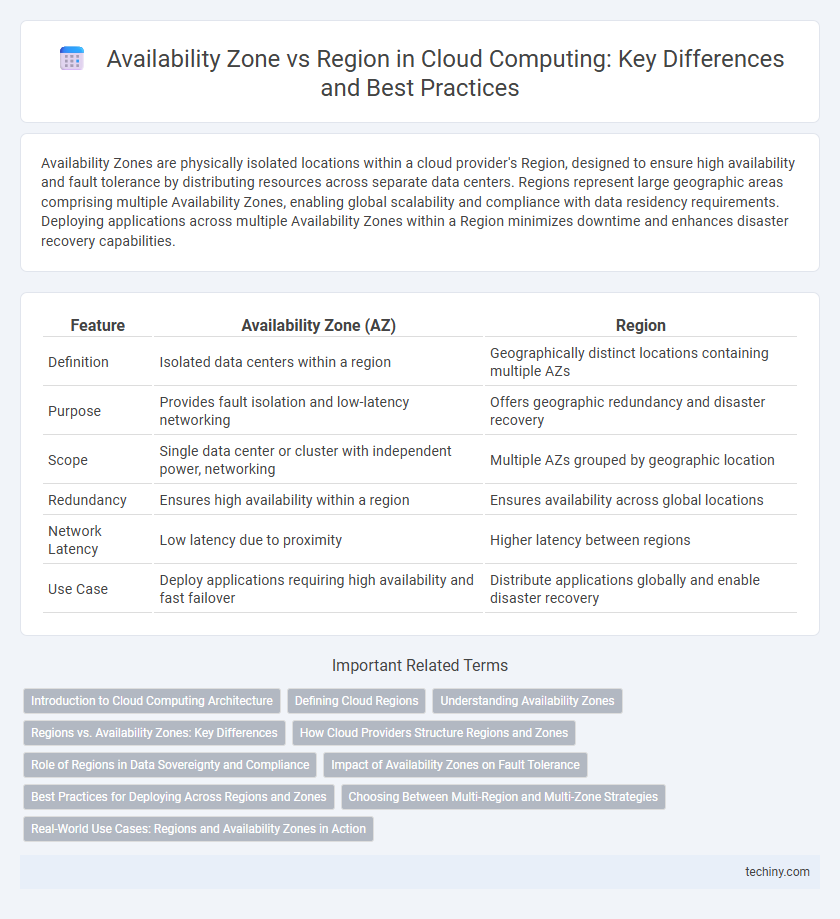Availability Zones are physically isolated locations within a cloud provider's Region, designed to ensure high availability and fault tolerance by distributing resources across separate data centers. Regions represent large geographic areas comprising multiple Availability Zones, enabling global scalability and compliance with data residency requirements. Deploying applications across multiple Availability Zones within a Region minimizes downtime and enhances disaster recovery capabilities.
Table of Comparison
| Feature | Availability Zone (AZ) | Region |
|---|---|---|
| Definition | Isolated data centers within a region | Geographically distinct locations containing multiple AZs |
| Purpose | Provides fault isolation and low-latency networking | Offers geographic redundancy and disaster recovery |
| Scope | Single data center or cluster with independent power, networking | Multiple AZs grouped by geographic location |
| Redundancy | Ensures high availability within a region | Ensures availability across global locations |
| Network Latency | Low latency due to proximity | Higher latency between regions |
| Use Case | Deploy applications requiring high availability and fast failover | Distribute applications globally and enable disaster recovery |
Introduction to Cloud Computing Architecture
Availability Zones are isolated data centers within a cloud provider's Region, designed to enhance fault tolerance and ensure high availability by distributing resources geographically. Regions consist of multiple Availability Zones, providing redundancy and minimizing latency for cloud services by being strategically located around the globe. This architecture enables scalable, resilient, and low-latency applications critical for modern cloud computing environments.
Defining Cloud Regions
Cloud regions are geographically distinct areas that contain multiple data centers designed to provide redundancy and low latency for cloud computing services. Each region is composed of multiple Availability Zones, which are isolated locations within the region that enhance fault tolerance by distributing resources across independent infrastructure. Defining cloud regions allows organizations to optimize data residency, compliance, and disaster recovery strategies.
Understanding Availability Zones
Availability Zones are distinct data centers within a cloud provider's Region, designed to ensure high availability and fault tolerance by isolating infrastructure. Each Availability Zone operates independently with separate power, cooling, and networking, enabling architects to distribute applications and data for redundancy. Understanding this separation is critical for designing resilient cloud architectures that minimize downtime and maintain service continuity.
Regions vs. Availability Zones: Key Differences
Regions represent large geographic areas containing multiple Availability Zones, which are isolated data centers designed to enhance fault tolerance and redundancy. Availability Zones within a region enable high availability and disaster recovery by distributing resources across physically separated locations. Selecting the appropriate region impacts latency, compliance, and service availability, while choosing specific Availability Zones ensures resilience and optimized workload distribution.
How Cloud Providers Structure Regions and Zones
Cloud providers organize their infrastructure into regions and availability zones to enhance redundancy and minimize latency. A region represents a distinct geographic area containing multiple isolated availability zones, each with independent power, networking, and cooling. This hierarchical structure enables fault tolerance and high availability by allowing workloads to be distributed across multiple physically separated zones within a single region.
Role of Regions in Data Sovereignty and Compliance
Regions play a critical role in ensuring data sovereignty and compliance by allowing organizations to store and process data within specific geopolitical boundaries, adhering to local regulations and privacy laws. Each region comprises multiple Availability Zones, providing fault tolerance and redundancy while maintaining legal control over data location. Choosing the appropriate region helps businesses meet regulatory requirements such as GDPR, HIPAA, and other jurisdiction-specific mandates.
Impact of Availability Zones on Fault Tolerance
Availability Zones enhance fault tolerance by isolating cloud resources in separate physical locations within a cloud Region, reducing the risk of service disruption caused by localized failures. Each Availability Zone operates independently with its own power, cooling, and networking, ensuring that a failure in one zone does not affect others. Distributing applications and data across multiple Availability Zones significantly improves redundancy and uptime, enabling businesses to maintain continuous service availability.
Best Practices for Deploying Across Regions and Zones
Deploying applications across multiple Availability Zones within a single Region enhances fault tolerance by minimizing the impact of Zone-specific failures through data replication and load balancing. Spreading resources across multiple Regions provides disaster recovery capabilities against Regional outages but requires careful management of latency, data compliance, and network security policies. Best practices for multi-region deployment include automated failover, synchronized backups, and consistent configurations to ensure high availability and business continuity.
Choosing Between Multi-Region and Multi-Zone Strategies
Multi-Region strategies enhance disaster recovery and compliance by distributing workloads across geographically separated data centers, minimizing latency for global users. Multi-Zone approaches improve fault tolerance within a single region by isolating resources in separate availability zones to maintain uptime during localized failures. Selecting between Multi-Region and Multi-Zone depends on factors such as latency requirements, regulatory compliance, and cost implications for global versus regional resilience.
Real-World Use Cases: Regions and Availability Zones in Action
Regions and Availability Zones enable cloud providers to deliver high availability and fault tolerance by distributing resources geographically; for example, deploying applications across multiple Availability Zones within a region mitigates data center failures. Enterprises use regions to comply with data residency laws, such as GDPR, by choosing cloud regions located within specific countries. Disaster recovery architectures leverage multiple regions to ensure business continuity during large-scale outages or natural disasters, maintaining uptime and minimizing data loss.
Availability Zone vs Region Infographic

 techiny.com
techiny.com